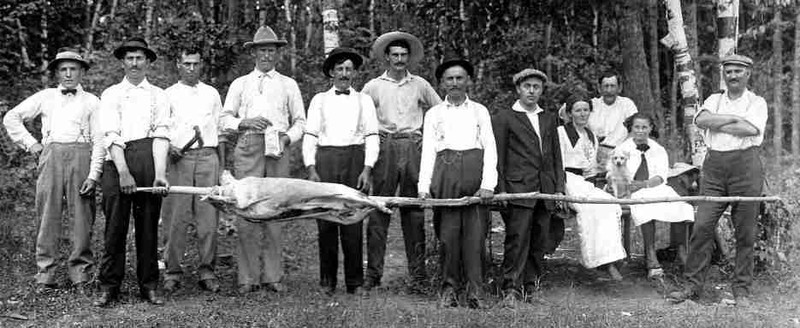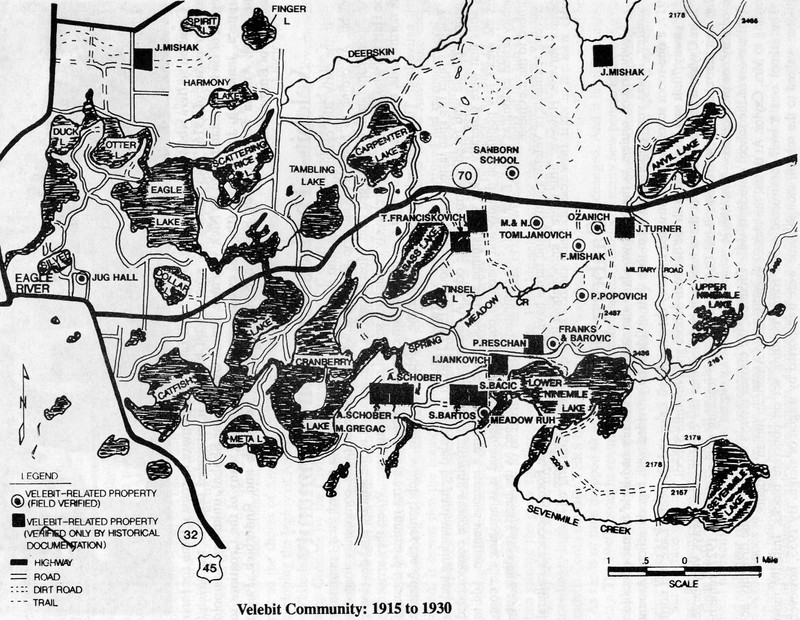Velebit, A Croatian Community
Introduction
Text-to-speech Audio
Croatian immigration to the United States began 1900 and accelerated after World War I. Many of those coming to Eagle River moved from another location in The United States. They were attracted by advertisement for farm land, which was in reality cutover logging land with few or no improvements. They invested life savings and met with fields of stumps and sandy soil. This is a story of survival and determination.
Images
Croatian picnic 1916

Hand drawn map of Velebit settlement

Backstory and Context
Text-to-speech Audio
The area of settlement known as “Velebit” is located about eight miles east of Eagle River, Wisconsin and is roughly bordered by Highway 70 to the north, Military Road on the east, Nine Mile Road on the south and East Bass Lake Road to the west.
Velebit was settled by Croatian immigrants between the years 1915 – 1930. Settlers named it for a mountain region of Croatia in the south, known for rocky land with pockets of good soil.
“According to one source, the land company which brought our people to Eagle River planned to sell each family a forty with a house and barn on it for $2,000. A horse, cow, pig, and some chickens were to be included in the deal. A model farm was set up north of town from which they could learn to farm. If the above plan was ever fully carried out, we could find no record of it. Our own families got no animals. During interviews we heard many horror stories of people arriving by train with all their possessions expecting to move into a home, only to find no building on their property at all. One family found only a chicken coop type building. Some found no cleared land or only an acre or two. In some cases, the land was mostly marsh. Many had to hurry up and put up some kind of shelter for their families before the deadly winter set in. With small savings exhausted by down payments and moving, and no jobs, there was no money for food or equipment. One family ate only meal all of the first winter. Some were lucky to be sold farms with buildings already on them, when earlier settlers abandoned farming, but these farms carried the over-inflated mortgages of the World War I boom, impossible to pay off in the deflated economy of the post war years. No wonder that immigrants, Creation, Finlander, and others, who had been brought here by pie-in-the-sky ads in their own foreign-language papers, were deeply resentful and felt they had been cheated, many left, but those who stayed, being inured from their childhoods to labor and hardship, eventually carved out for themselves a tolerable life in this area. They and their children became part of the American "melting-pot", Their descendants can now be found in academic, professional, political, and high-technology fields, as well as in services and industry.”
The land sales were handled by the Sanborn Land Company through a local agent of Croatian descent, Joseph Habrich (Josip Srecko Hrabic). Mr. Habrich arrived in Eagle River in 1913. Ads for farmland were published in Croatian language newspapers, both in the United States and Europe. Many of the settlers lost all they invested. The climate was daunting, the land poor and the ‘farms’ were 40 acre plots of cut over timber land full of stumps.
The promotional material provided a photo of a model farm (which actually existed) called Meadow Ruh, showing a home, barn, cleared land and livestock. The farms purchased had none of these amenities.
In 1989 the U.S. Forest Service conducted a multi-faceted investigation of the largely abandoned community. There were several remnants of homes and farms. A Forest Service cultural resources team conducted a literature and archival review, a field survey and oral histories with descendants. The team used standardized questions and involved eight informants knowledgeable in local history.
Sources
Bubanovich, Elizabeth . Keeler, Mary. Memories of Croation Settlers of Eagle River. Blue Winds Printing and Design, 1984.
U.S. Forest Service. Velebit Historical Investigations of A Early 20th Century Croatian Community. Published October 1st, 1989. U. S. Forest Service.
Eagle River Historical Society archive
Eagle River Historical Society archive
